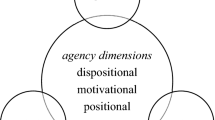Abstract
A child with special needs will flourish and benefit from an early childhood environment that empowers learning. Center learning empowers a child to be actively engaged in self-directed learning based on strength, ability, and interest. Center learning can enhance interactive language, story response, art, reading and writing-like behavior, collaboration, buddy activity, and independence. All of these empowering areas of development are strongly related to the child's emergent literacy development. The variety of center learning experiences is limited only by the imagination; this article provides a selection of start-up ideas for the early childhood educator.
Similar content being viewed by others
REFERENCES
Allen, J., & Mason, J. (Eds.). (1989). Risk makers, risk takers, risk breakers. Portsmouth, NH: Heinemann.
Applebee, A. N., & Langer, J. (1983) Instructional scaffolding: Reading and writing as natural language activities. Language Arts, 60, 168–175.
Butler, D., & Clay, M. (1979). Reading begins at home. Portsmouth, NH: Heinemann.
Breen, M. J., & Fiedler, C. R. (1996). Behavioral approach to assessment of youth with emotional/ behavioral disorders. Austin, TX: Pro-Ed.
Cowley, J. (1980). Mrs. Wishy-washy. Bothell, WA: Wright Group.
Clay, M. M. (1966). Emergent reading behavior. Doctoral dissertation, University of Auckland, New Zealand.
Morrow, L. (1993). Literacy development in the early years: Helping children read and write. Boston: Allyn & Bacon.
Salinger, T. (1996). Literacy for young children. Columbus, OH: Merrill.
Teale, W. (1982). Toward a theory of how children learn to read and write naturally. Language Arts, 58, 555–570.
Teale, W. (1986). The beginnings of reading and writing: Written language development during the preschool and kindergarten and preschool years. In M. Sampson (Ed.), The pursuit of literacy: Early reading and writing. Dubuque, IA: Kendall Hunt.
Tompkins, G. E. (1995). Language arts: Content and teaching strategies. Englewood Cliffs, NJ: Merrill/Prentice-Hall.
Wood, J. W. (1993). Mainstreaming: A practical approach for teachers. (2nd ed.). New York: Merrill/MacMillian.
Ysseldyke, J. E., & Algozzine, B. (1995). Special education: A practical approach for teachers. Boston: Houghton Mifflin.
Author information
Authors and Affiliations
Rights and permissions
About this article
Cite this article
Genisio, M., Drecktrah, M. Emergent Literacy in an Early Childhood Classroom: Center Learning to Support the Child with Special Needs. Early Childhood Education Journal 26, 225–231 (1999). https://doi.org/10.1023/A:1022911605995
Issue Date:
DOI: https://doi.org/10.1023/A:1022911605995




